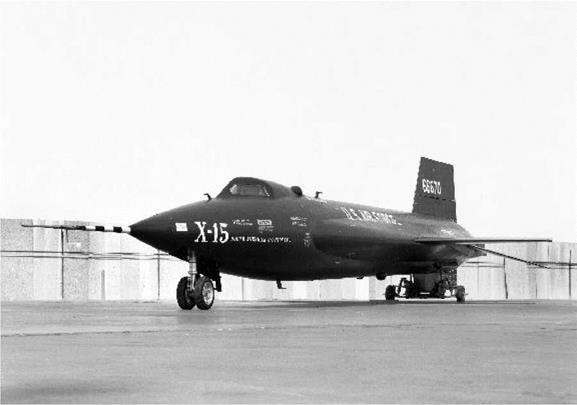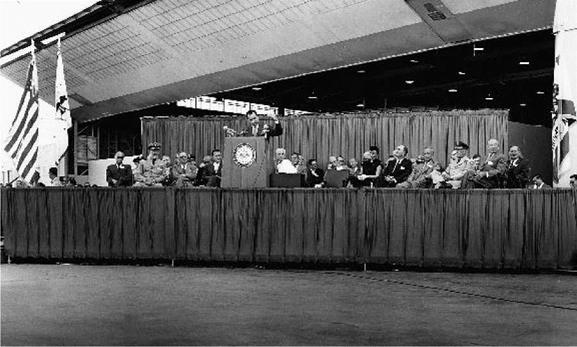The Flight Program
By January 1958, everything had moved into high gear and North American was assembling the three model NA-240 airplanes at its facility in Inglewood, adjacent to the Los Angeles International Airport. The company had released over 6,000 engineering drawings-including one that was 50 feet long-by the end of 1957, although it continued to make minor changes to the configuration. North American subcontracted about 200 items to various vendors, but manufactured the majority of the airplane on the premises.-11
ROLLOUT
On 15 October 1958, North American rolled out the first X-15 (56-6670) in Inglewood to great pomp and circumstance. It was ironic, in a way. The NACA had given birth to a concept and had nurtured the X-15 for over four years, but two weeks earlier the committee itself had ceased to exist. In its place, the National Aeronautics and Space Administration (NASA) was created effective 1 October 1958. The X-15 had been the largest development program at the NACA; it would soon be one of the smallest at a moon-destined NASA.
|
|
X-15-1 was presented during the roll-out ceremony. The air-data boom on the nose would be
used until the ball nose was ready. The bug-eye camera ports located behind the canopy and under the fuselage in the center-of-gravity compartment would provide some breathtaking views of the early flights courtesy of National Geographic. (North American Aviation).
The master of ceremonies at the rollout was Raymond H. Rice, vice president and general manager of the Los Angeles division of North American Aviation. The keynote speakers included Major General Victor R. Haugen, deputy commander of the ARDC; Brigadier General Marcus F. Cooper, commander of the AFFTC; Walt Williams, chief of the HSFS; and Harrison Storms, chief engineer for the Los Angeles division. Also in attendance were six future X-15 pilots: Neil A. Armstrong, A. Scott Crossfield, John B. McKay, Captain Robert A. Rushworth, Joseph A. Walker, and Captain Robert M. White.[2]
Congressmen and senators sat in the grandstands and Vice President Richard M. Nixon was on hand to proclaim that the X-15 had "recaptured the U. S. lead in space." There were special exhibits featuring a David Clark full-pressure suit and a mockup of the Reaction Motors XLR99 engine. Guests could sit in the X-15 fixed-base simulator, and attend a gala luncheon where everybody praised the efforts of all involved. For the X-15 team it was a moving occasion and a much-needed respite from the years of hard work.[3]
Bob White, the man who felled every Mach number and altitude milestone in the X-15, later remembered eloquently, "The X-15 … was in the public eye from its inception and grew almost asymptotically from the day of its manufacture. Witness the presence of the vice president of the United States at the X-15 rollout ceremony. The X-15 was not controversial; it was audacious. It literally vibrated the imagination that this aircraft would double the fastest speed by more than three whole Mach numbers and… fly out of the atmosphere, into space, and back again to an on – Earth landing. The X-15 did these things and many more….,,[4]
The space race had already begun, and the United States was eager to show any progress toward besting the Soviet accomplishments. Newspapers, magazines, and newsreels all heralded the X – 15 as the American entry in the space race. Considering that only four years earlier researchers had wanted to remove the "space leap" from the X-15 concept, it was ironic that many now portrayed this small black airplane as America’s response to the Soviet threat. It may have been small, but it had not come cheaply. Despite the original $12,200,000 estimate prepared by the WADC in 1954, at the time of the rollout Major General Haugen estimated that the government had spent nearly $120 million-and the airplane had not yet flown.-15
Haugen also pointed out that the X-15 rollout was taking place two weeks ahead of the schedule established in June 1956, calling this "a tribute to all of the government and industry team." The general then summed up the spirit of the program: "It has been said that there are two extremes to research or exploratory flying-the approach that, for example, would strap a man on an ICBM and see what happens, and the super safe approach that would have us take tiny steps into the unknown and be absolutely sure of each step. We believe the solution is neither of these but rather a bold step into the future within the known technical capabilities of our engineers. We believe that the X-15 represents such a bold step… that will help us build better air and space vehicles in the future."[6]
Perhaps because his base would host the flight testing, Brigadier General Cooper was a little more cautious in his remarks: "I wish to point out here that this research program will be one of long duration, and the type of flights which excite the imagination and make newspaper headlines are many, many months away." However, the general could not resist riding the space bandwagon, at least a little, by calling the program "the first major breakthrough in sustained piloted space
|
flight."17!
|
Given the recent successes of the Soviets with Sputnik, the rollout of the X-15 was considered sufficiently important for the vice president of the United States to show up. Richard M. Nixon presided over the ceremonies along with distinguished speakers from the Air Force and the state of California. (North American Aviation)
Not to be outdone, Stormy Storms was even more direct: "The rollout of the X-15 marks the beginning of man’s most advanced assault on space. This will be one of the most dramatic, as in the X-15 we have all the elements and most of the problems of a true space vehicle." Describing the potential performance of the airplane, Storms said, "The performance of the X-15 is hard to comprehend. It can out fly the fastest fighters by a factor of three, a high-speed rifle bullet by a factor of two, and easily exceed the world altitude record by many times."81
Following the conclusion of the official ceremonies, North American moved the first X-15 back inside and prepared it for delivery. On the night of 16 October, covered completely in heavy-duty wrapping paper, X-15-1 traveled overland by truck through the Los Angeles foothills to Edwards for initial ground-test work.












